Spatiotemporal Distribution and Evolution of Air Pollutants Based on Comparative Analysis of Long-Term Monitoring Data and Snow Samples in Petroșani Mountain Depression, Romania
Abstract
1. Introduction
2. Materials and Methods
2.1. Overview of the Study Area
- By the old chairlift, commissioned in 1973, with a length of 2.24 km, a vertical rise of 612 m, and a speed of 2 m/s. It is the second longest chairlift in the country, after the one in Borșa, with the departure station located about 8 km from the city.
- By the new chairlift, TS3, put into operation in 2014, with the departure station located about 9 km from the city, in the Rusu area. This chairlift has a length of 2.2 km, a vertical rise of 420 m, and a speed of 6 m/s.
- By car, following the recent modernization of the terminal section of approximately 4.5 km of County Road 709 F, which connects the Rusu area to the alpine zone of Parâng Resort. Car access is only possible in summer, as this final segment is closed to public traffic in winter [58].
2.2. Sampling Site Layout
- The Rusu area and the Parâng resort;
- The central-northern part of the municipality, including the Brădet area;
- The workers’ colony/Historic quarter;
- The ring road.
- 11 air quality determination points, numbered from 1 to 11, were placed in the Rusu/Parâng area;
- 26 air quality determination points, numbered from 12 to 37, were placed in the Historic quarter/workers’ colony;
- 5 air quality determination points, numbered from 38 to 42, were placed in the central-northern area of Petroșani Municipality and the Brădet area.
2.3. Snow Sample Collection
- -
- 2–3 February 2019, snow sample collection, stage I;
- -
- 12–14 February 2023, snow sample collection, stage II;
- -
- February 2023, instrumental air determinations.
2.4. Analytical Instruments and Parameters
- Remote Sensing: Remote sensing techniques, including LiDAR and radar, can be employed to assess the depth and distribution of the snow layer. These data can then be utilized to estimate the quantity of pollutants that have been deposited within the snow.
- Field measurements: Snow samples can be collected from various locations and analyzed for pollutant concentrations. This data can be used to map the distribution of air pollutants.
- -
- Snow falling in unpolluted areas typically has a slightly alkaline pH, around 7.0.
- -
- Snow in polluted areas may have a more acidic pH, around 6.0 or lower.
- -
- Snow exposed to acid rain can have a very acidic pH, around 3.0 or lower.
- -
- Sulfur dioxide (SO2)
- -
- Nitrogen oxides (NOx)
- -
- Particulate matter (PM)
2.5. Dispersion Model Description
- Meteorological conditions, such as wind speed and direction, atmospheric turbulence levels characterized by what is called the stability class, air temperature, and the altitude of any thermal inversion base, if present.
- Emission parameters, including the location and height of the source, the diameter of the emission mouth, the velocity of the pollutant jet, the exit temperature, and the mass flow rate of the pollutant.
- Terrain elevation at the location of both the source and the receptor.
- Location, height, and width of any obstacles (such as buildings or other structures) in the path of the gas emission plume.
3. Results and Discussions
3.1. Spatial Distribution of Pollutants
- Gaseous substances exhibit a decreasing trend in the order of Historic quarter → City center → Parâng, as illustrated in Figure 5 for TVOC (Total Volatile Organic Compounds).
- Suspended particles also show a decreasing trend in the same order, as exemplified in Figure 6 for PM1, PM2.5, and PM10.
- Air Movements (Convection and Turbulence): Both gaseous pollutants and suspended particles are transported by air currents. Atmospheric convection lifts them to higher altitudes or disperses them horizontally, while atmospheric turbulence, driven by temperature and wind variations, facilitates their mixing and uniform distribution in the air.
- Wind and Long-Range Transport: Pollutants can be carried over long distances by wind, leading to the contamination of areas far from the pollution source. Larger particles (PM10) tend to settle more quickly, whereas finer particles (PM2.5 and PM0.1—nanoparticles) and gaseous pollutants remain air-borne for longer periods and may be transported hundreds or even thousands of kilometers.
- Atmospheric Diffusion: Both gases and ultrafine particles disperse due to random molecular motion in the air (Brownian diffusion), contributing to their homogenization in the atmosphere.
- Atmospheric Stratification: Under thermal inversion conditions, cold air near the surface becomes trapped beneath a layer of warmer air, preventing pollutant dispersion and leading to their accumulation at ground level. This phenomenon similarly affects both gaseous pollutants (e.g., NO2, SO2) and fine particles, resulting in increased local concentrations.
3.2. Temporal Trends
3.3. Snow Chemistry Analysis
- For substances dissolved in snow water, a decreasing trend is observed in the order of Historic quarter → City center → Parâng, as illustrated in Figure 9 for TDS.
- 2
- For substances deposited by sedimentation from the air, an increasing trend is observed in the same order, as exemplified in Figure 10 for sediment.
- Wet deposition is characteristic of gaseous pollutants and soluble aerosols, which dissolve in atmospheric water droplets or ice crystals and are transported with precipitation. This process increases the concentration of dissolved substances in snow.
- Dry deposition involves larger solid particles (PM10, PM2.5) that settle by gravity or are transported by wind, adhering to the snow surface. These do not dissolve immediately and may remain as visible particles.
- Low temperatures reduce the solubility of certain gases, which may lead to a discrepancy between the concentration of dissolved substances and that of solid particles.
- Wind intensity affects the transport of solid particles and can result in greater accumulation in specific areas.
3.4. Impact of Meteorological Factors
3.5. Dispersion Model Interpretation
3.6. Comparison Between Instrumental Air Quality Monitoring and Pollutant Determination in Snow
4. Conclusions
Supplementary Materials
Author Contributions
Funding
Institutional Review Board Statement
Informed Consent Statement
Data Availability Statement
Conflicts of Interest
Abbreviations
| PM | Particulate Matter |
| HCHO | Formaldehyde |
| TDS | Total Dissolved Solids |
| VOCs | Volatile Organic Compounds |
| TVOC | Total Volatile Organic Compounds |
References
- Calamar, A.-N.; Gaman, G.A.; Pupazan, D.; Toth, L.; Kovacs, I. Analysis of environmental components by monitoring gas concentrations in the environment. Environ. Eng. Manag. J. 2017, 16, 1249–1256. [Google Scholar] [CrossRef]
- Sharma, A.; Mitra, A.; Sharma, S.; Roy, S. Estimation of Air Quality Index from Seasonal Trends Using Deep Neural Network. In Artificial Neural Networks and Machine Learning–ICANN 2018: 27th International Conference on Artificial Neural Networks, Rhodes, Greece, October 4–7, 2018, Proceedings, Part III; Springer: Berlin/Heidelberg, Germany, 2018; pp. 511–521. [Google Scholar] [CrossRef]
- Taştan, M.; Gökozan, H. Real-Time Monitoring of Indoor Air Quality with Internet of Things-Based E-Nose. Appl. Sci. 2019, 9, 3435. [Google Scholar] [CrossRef]
- Lorinț, C.; Danciu, C.; Traistă, E.; Florea, A.; Rezmerița, E. Aspects regarding the impact of cloth waste burning in the historical residential areas of the Petroșani municipality. MATEC Web Conf. 2024, 389, 83. [Google Scholar] [CrossRef]
- Wang, Q.; Ao, R.; Chen, H.; Li, J.; Wei, L.; Wang, Z. Characteristics of PM2.5 and CO2 Concentrations in Typical Functional Areas of a University Campus in Beijing Based on Low-Cost Sensor Monitoring. Atmosphere 2024, 15, 1044. [Google Scholar] [CrossRef]
- Afifa; Arshad, K.; Hussain, N.; Ashraf, M.H.; Saleem, M.Z. Air pollution and climate change as grand challenges to sustainability. Sci. Total Environ. 2024, 928, 172370. [Google Scholar] [CrossRef]
- Neira, M.; Prüss-Ustün, A.; Mudu, P. Reduce air pollution to beat NCDs: From recognition to action. Lancet 2018, 392, 1178–1179. [Google Scholar] [CrossRef]
- Chukwu, T.M.; Morse, S.; Murphy, R.J. Spatial Analysis of Air Quality Assessment in Two Cities in Nigeria: A Comparison of Perceptions with Instrument-Based Methods. Sustainability 2022, 14, 5403. [Google Scholar] [CrossRef]
- Word Health Organization. WHO Global Air Quality Guidelines: Particulate Matter (PM2.5 and PM10), Ozone, Nitrogen Dioxide, Sulfur Dioxide and Carbon Monoxide; World Health Organization: Geneva, Switzerland, 2021; ISBN 978-92-4-003422-8. Available online: https://iris.who.int/handle/10665/345329 (accessed on 19 March 2025).
- Rezmerița, E.; Radu, S.M.; Călămar, A.-N.; Lorinț, C.; Florea, A.; Nicola, A. Urban Air Quality Monitoring in Decarbonization Context; Case Study—Traditional Coal Mining Area, Petroșani, Romania. Sustainability 2022, 14, 8165. [Google Scholar] [CrossRef]
- Sustainable Development Goal Indicator 3.9.1: Mortality Attributed to air Pollution [Internet]. Available online: https://www.who.int/publications/i/item/9789240099142 (accessed on 19 March 2025).
- Leung, D.Y.C. Outdoor-indoor air pollution in urban environment: Challenges and opportunity. Front. Environ. Sci. 2015, 2, 69. [Google Scholar] [CrossRef]
- Azuma, K.; Kagi, N.; Yanagi, U.; Osawa, H. Effects of low-level inhalation exposure to carbon dioxide in indoor environments: A short review on human health and psychomotor performance. Environ. Int. 2018, 121, 51–56. [Google Scholar] [CrossRef]
- Kampa, M.; Castanas, E. Human health effects of air pollution. Environ. Pollut. 2008, 151, 362–367. [Google Scholar] [CrossRef] [PubMed]
- Lelieveld, J.; Evans, J.S.; Fnais, M.; Giannadaki, D.; Pozzer, A. The contribution of outdoor air pollution sources to premature mortality on a global scale. Nature 2015, 525, 367–371. [Google Scholar] [CrossRef] [PubMed]
- Cohen, A.J.; Brauer, M.; Burnett, R.; Anderson, H.R.; Frostad, J.; Estep, K.; Balakrishnan, K.; Brunekreef, B.; Dandona, L.; Dandona, R.; et al. Estimates and 25-year trends of the global burden of disease attributable to ambient air pollution: An analysis of data from the Global Burden of Diseases Study 2015. Lancet 2017, 389, 1907–1918. [Google Scholar] [CrossRef]
- Annesi-Maesano, I.; Baiz, N.; Banerjee, S.; Rudnai, P.; Rive, S.; Sinphonie Group. Indoor Air Quality and Sources in Schools and Related Health Effects. J. Toxicol. Environ. Health Part B 2013, 16, 491–550. [Google Scholar] [CrossRef]
- Chapman, E.G.; Gustafson, W.I.J.; Easter, R.C.; Barnard, J.C.; Ghan, S.J.; Pekour, M.S.; Fast, J.D. Coupling aerosol-cloud-radiative processes in the WRF-Chem model: Investigating the radiative impact of elevated point sources. Atmos. Chem. Phys. 2009, 9, 945–964. [Google Scholar] [CrossRef]
- Dong, F.; Yu, B.; Pan, Y. Examining the synergistic effect of CO2 emissions on PM2.5 emissions reduction: Evidence from China. J. Clean. Prod. 2019, 223, 759–771. [Google Scholar] [CrossRef]
- Yang, S.; Chen, B.; Ulgiati, S. Co-benefits of CO2 and PM2.5 Emission Reduction. Energy Procedia 2016, 104, 92–97. [Google Scholar] [CrossRef]
- Rojas González, L.; Montilla-Rosero, E. Evaluation of In-Situ Low-Cost Sensor Network in a Tropical Valley, Colombia. Sensors 2025, 25, 1236. [Google Scholar] [CrossRef]
- Zhan, C.; Xie, M.; Lu, H.; Liu, B.; Wu, Z.; Wang, T.; Zhuang, B.; Li, M.; Li, S. Impacts of urbanization on air quality and the related health risks in a city with complex terrain. Atmos. Chem. Phys. 2023, 23, 771–788. [Google Scholar] [CrossRef]
- Yarce Botero, A.; Lopez Restrepo, S.; Sebastian Rodriguez, J.; Valle, D.; Galvez-Serna, J.; Montilla, E.; Botero, F.; Henzing, B.; Segers, A.; Heemink, A.; et al. Design and Implementation of a Low-Cost Air Quality Network for the Aburra Valley Surrounding Mountains. Pollutants 2023, 3, 150–165. [Google Scholar] [CrossRef]
- Martínez, J.; Olaya Morales, Y.; Kumar, P. Spatial and temporal variability of urban cyclists’ exposure to PM2.5 in Medellín, Colombia. Atmos. Pollut. Res. 2024, 15, 101946. [Google Scholar] [CrossRef]
- Sakai, H.; Sasaki, T.; Saito, K. Heavy metal concentrations in urban snow as an indicator of air pollution. Sci. Total Environ. 1988, 77, 163–174. [Google Scholar] [CrossRef] [PubMed]
- Munawer, M.E. Human health and environmental impacts of coal combustion and post-combustion wastes. J. Sustain. Min. 2018, 17, 87–96. [Google Scholar] [CrossRef]
- Amoatey, P.; Omidvarborna, H.; Baawain, M.S.; Al-Mamun, A. Emissions and exposure assessments of SOX, NOX, PM10/2.5 and trace metals from oil industries: A review study (2000–2018). Process Saf. Environ. Prot. 2019, 123, 215–228. [Google Scholar] [CrossRef]
- Koshland, C.P. Impacts and control of air toxics from combustion. Symp. (Int.) Combust. 1996, 26, 2049–2065. [Google Scholar] [CrossRef]
- Durmishi, B.H.; Durmishi, A.; Shabani, A. The role of instrumental methods in chemical analysis for environmental protection. Int. J. Chem. Mater. Sci. (IJCMS) 2025, 10, 1–22. [Google Scholar] [CrossRef]
- Beck, D.; Mitkiewicz, J. A systematic literature review of citizen science in urban studies and regional urban planning: Policy, practical, and research implications. Urban Ecosyst. 2025, 28, 85. [Google Scholar] [CrossRef]
- Marenaci, P.; Otal, L.E. Sentinel 4: A geostationary imaging UVN spectrometer for air quality monitoring: Optical alignment of the Instrument Flight Model 2. In Proceedings of the Optical Design and Engineering IX, Strasbourg, France, 7–12 April 2024; Volume 13019, pp. 253–271. Available online: https://www.spiedigitallibrary.org/conference-proceedings-of-spie/13019/1301918/Sentinel-4--a-geostationary-imaging-UVN-spectrometer-for-air/10.1117/12.3017155.full (accessed on 19 March 2025).
- Ajibola, A.S.; Adeshina, S.; Ojo, T.O. Levels and ecological risk assessment of UV filters in sediments of Odo-Iyaalaro River and Eleyele Lake, Nigeria. Discov. Environ. 2025, 3, 32. [Google Scholar] [CrossRef]
- Barro, R.; Regueiro, J.; Llompart, M.; Garcia-Jares, C. Analysis of industrial contaminants in indoor air: Part 1. Volatile organic compounds, carbonyl compounds, polycyclic aromatic hydrocarbons and polychlorinated biphenyls. J. Chromatogr. A 2009, 1216, 540–566. [Google Scholar] [CrossRef]
- Santamaría, C.; Elustondo, D.; Lasheras, E.; Santamaría, J.M. Air Pollutants in the Outdoor Environment (NOx, SO2, VOCs, HAPs [CO, O3]). In Chromatographic Analysis of the Environment; CRC Press: Boca Raton, FL, USA, 2017; ISBN 978-1-315-31620-8. [Google Scholar]
- Ntesat, U.B.; Bright, N.; Chima, D.I.; Ayotamuno, M.J. Investigation of the Level of Air Pollution Caused by Crude Oil Production and its Health Effects on the Inhabitants of the Production Area. Int. J. Eng. Inf. Syst. (IJEAIS) 2024, 8, 25–31. [Google Scholar]
- Sa’adeh, H.; Chiari, M. Characterization of particulate matter (PM2.5 and PM10) in an urban area in Amman by PIXE, PESA, optical and gravimetric measurements. Nucl. Instrum. Methods Phys. Res. Sect. B Beam Interact. Mater. At. 2024, 553, 165388. [Google Scholar] [CrossRef]
- Saporito, A.F.; Gordon, T.; Kim, B.; Huynh, T.; Khan, R.; Raja, A.; Terez, K.; Camacho-Rivera, N.; Gordon, R.; Gardella, J.; et al. Skyrocketing pollution: Assessing the environmental fate of July 4th fireworks in New York City. J. Expo. Sci. Environ. Epidemiol. 2024, 1–9. [Google Scholar] [CrossRef] [PubMed]
- Borhan, M.S.; Khanaum, M.M. Sensors and Methods for Measuring Greenhouse Gas Emissions from Different Components of Livestock Production Facilities. J. Geosci. Environ. Prot. 2022, 10, 242–272. [Google Scholar] [CrossRef]
- Ma, W.; Ji, X.; Ding, L.; Yang, S.X.; Guo, K.; Li, Q. Automatic Monitoring Methods for Greenhouse and Hazardous Gases Emitted from Ruminant Production Systems: A Review. Sensors 2024, 24, 4423. [Google Scholar] [CrossRef]
- Sobus, J.R.; Sayre-Smith, N.A.; Chao, A.; Ferland, T.M.; Minucci, J.M.; Carr, E.T.; Brunelle, L.D.; Batt, A.L.; Whitehead, H.D.; Cathey, T.; et al. Automated QA/QC reporting for non-targeted analysis: A demonstration of “INTERPRET NTA” with de facto water reuse data. Anal. Bioanal. Chem. 2025, 417, 1897–1914. [Google Scholar] [CrossRef]
- Jin, D.; Lu, Z.; Song, X.; Ahammed, G.J.; Yan, Y.; Chen, S. Improvement of Yield and Quality Properties of Radish by the Organic Fertilizer Application Combined with the Reduction of Chemical Fertilizer. Agronomy 2024, 14, 1847. [Google Scholar] [CrossRef]
- Bellini, A.; Diémoz, H.; Di Liberto, L.; Gobbi, G.P.; Bracci, A.; Pasqualini, F.; Barnaba, F. ALICENET—An Italian network of automated lidar ceilometers for four-dimensional aerosol monitoring: Infrastructure, data processing, and applications. Atmos. Meas. Tech. 2024, 17, 6119–6144. [Google Scholar] [CrossRef]
- Johann, S.; Düster, M.; Bellanova, P.; Schwarzbauer, J.; Weber, A.; Wolf, S.; Schüttrumpf, H.; Lehmkuhl, F.; Hollert, H. Dioxin-like and estrogenic activity screening in fractionated sediments from a German catchment after the 2021 extreme flood. Environ. Sci. Eur. 2024, 36, 163. [Google Scholar] [CrossRef]
- Zhang, Y.; Zhao, T.; Sun, X.; Bai, Y.; Shu, Z.; Fu, W.; Lu, Z.; Wang, X. Ozone pollution aggravated by mountain-valley breeze over the western Sichuan Basin, Southwest China. Chemosphere 2024, 361, 142445. [Google Scholar] [CrossRef]
- Popescu, F.D.; Radu, S.M.; Andras, A.; Brinas, I.; Marita, M.-O.; Radu, M.A.; Brinas, C.L. Stability Assessment of the Dam of a Tailings Pond Using Computer Modeling—Case Study: Coroiești, Romania. Appl. Sci. 2024, 14, 268. [Google Scholar] [CrossRef]
- Planchon, F.A.M.; Boutron, C.F.; Barbante, C.; Cozzi, G.; Gaspari, V.; Wolff, E.W.; Ferrari, C.P.; Cescon, P. Changes in heavy metals in Antarctic snow from Coats Land since the mid-19th to the late-20th century. Earth Planet. Sci. Lett. 2002, 200, 207–222. [Google Scholar] [CrossRef]
- Baltrėnas, P.; Baltrėnaitė, E. Natural and Semi-Natural Biogeochemical Barriers as Natural Technologies. In Sustainable Environmental Protection Technologies: Contaminant Biofiltration, Adsorption and Stabilization; Baltrėnas, P., Baltrėnaitė, E., Eds.; Springer International Publishing: Cham, Switzerland, 2020; pp. 39–91. ISBN 978-3-030-47725-7. [Google Scholar]
- Krastinytė, V.; Baltrėnaitė, E.; Lietuvninkas, A. Analysis of snow-cap pollution for air quality assessment in the vicinity of an oil refinery. Environ. Technol. 2013, 34, 757–763. [Google Scholar] [CrossRef] [PubMed]
- Muir, D.; Gunnarsdóttir, M.J.; Koziol, K.; von Hippel, F.A.; Szumińska, D.; Ademollo, N.; Corsolini, S.; Silva, A.D.; Gabrielsen, G.; Kallenborn, R.; et al. Local sources versus long-range transport of organic contaminants in the Arctic: Future developments related to climate change. Environ. Sci. Adv. 2025, 4, 355–408. [Google Scholar] [CrossRef]
- Potapowicz, J.; Szumińska, D.; Szopińska, M.; Polkowska, Ż. The influence of global climate change on the environmental fate of anthropogenic pollution released from the permafrost: Part I. Case study of Antarctica. Sci. Total Environ. 2019, 651, 1534–1548. [Google Scholar] [CrossRef]
- Skiles, S.M.; Flanner, M.; Cook, J.M.; Dumont, M.; Painter, T.H. Radiative forcing by light-absorbing particles in snow. Nat. Clim. Change 2018, 8, 964–971. [Google Scholar] [CrossRef]
- Rezmerița, E.; Florea, A.; Lorint, C. Atmospheric Pollutant Dispersion Modeling: A Case Study of the Transit Road in Petroșani Municipality. In Proceedings of the 18th National Student Symposium “Geoecology”, Petroşani, Romania, 6–7 May 2021; Volume 17, pp. 97–102. (In Romanian). [Google Scholar]
- Primăria Municipiului Petroșani-Primaria [Internet]. Available online: https://www.primariapetrosani.ro/ (accessed on 18 March 2025).
- Google Maps [Internet]. Available online: https://www.google.com/maps (accessed on 18 March 2025).
- Google Earth [Internet]. Available online: https://earth.google.com/web/@0,-0.52266016,0a,22251752.77375655d,35y,0h,0t,0r/data=CgRCAggBOgMKATBCAggASg0I____________ARAA (accessed on 18 March 2025).
- Petroșani [Internet]. Available online: https://petrosani-city.map2web.eu/# (accessed on 18 March 2025).
- Simion, A.G.; Andronache, I.; Ahammer, H.; Marin, M.; Loghin, V.; Nedelcu, I.D.; Popa, C.M.; Peptenatu, D.; Jelinek, H.F. Particularities of Forest Dynamics Using Higuchi Dimension. Parâng Mountains as a Case Study. Fractal Fract. 2021, 5, 96. [Google Scholar] [CrossRef]
- Centrul National de Informare si Promovare Turistica Petrosani [Internet]. Available online: https://cniptpetrosani.ro/ (accessed on 13 February 2025).
- Rezmerița, E. Air Quality Monitoring and Pollutants Dispersion Modeling in Petrosani City in the Context of Decarbonization and Restructuring of The Mining Industry. Ph.D. Thesis, University of Petrosani, Petroșani, Romania, 2024. [Google Scholar]
- Doherty, S.J.; Grenfell, T.C.; Forsström, S.; Hegg, D.L.; Brandt, R.E.; Warren, S.G. Observed vertical redistribution of black carbon and other insoluble light-absorbing particles in melting snow. J. Geophys. Res. Atmos. 2013, 118, 5553–5569. [Google Scholar] [CrossRef]
- Cipro, C.V.Z.; Taniguchi, S.; Montone, R.C. Organic Pollutants in Snow and Seasonal Melting Water from King George Island, Antarctica. Water Air Soil Pollut. 2017, 228, 149. [Google Scholar] [CrossRef]
- Cerasa, M.; Balducci, C.; Giannelli Moneta, B.; Guerriero, E.; Feo, M.L.; Bacaloni, A.; Mosca, S. Mastering Snow Analysis: Enhancing Sampling Techniques and Introducing ACF Extraction Method with Applications in Svalbard. Molecules 2024, 29, 5111. [Google Scholar] [CrossRef]
- Křeček, J.; Šedivá, L.; Palán, L.; Stuchlík, E. Environmental Role of Snowmelt in Headwaters Affected by Atmospheric Acid Deposition. Water 2023, 15, 2458. [Google Scholar] [CrossRef]
- Miśkowiec, P. The impact of the mountain barrier on the spread of heavy metal pollution on the example of Gorce Mountains, Southern Poland. Environ. Monit. Assess. 2022, 194, 663. [Google Scholar] [CrossRef] [PubMed]
- Molina, C.; Toro A, R.; Morales S, R.G.E.; Manzano, C.; Leiva-Guzmán, M.A. Particulate matter in urban areas of south-central Chile exceeds air quality standards. Air Qual. Atmos. Health 2017, 10, 653–667. [Google Scholar] [CrossRef]
- Zikovsky, L.; Badillo, M. An indirect study of air pollution by neutron activation analysis of snow. J. Radioanal. Nucl. Chem. Artic. 1987, 114, 147–153. [Google Scholar] [CrossRef]
- Howlett, C.; González Abad, G.; Chan Miller, C.; Nowlan, C.R.; Ayazpour, Z.; Zhu, L.; Howlett, C.; González Abad, G.; Chan Miller, C.; Nowlan, C.R.; et al. The influence of snow cover on Ozone Monitor Instrument formaldehyde observations. Atmósfera 2023, 37, e53134. [Google Scholar] [CrossRef]
- Baah, G.A.; Savin, I.Y.; Vernyuk, Y.I. Pollution from Highways Detection Using Winter UAV Data. Drones 2023, 7, 178. [Google Scholar] [CrossRef]
- Nawrot, A.P.; Migała, K.; Luks, B.; Pakszys, P.; Głowacki, P. Chemistry of snow cover and acidic snowfall during a season with a high level of air pollution on the Hans Glacier, Spitsbergen. Polar Sci. 2016, 10, 249–261. [Google Scholar] [CrossRef]
- Lorint, C. Comparative Study of Urban Geology, Human Ecology, and Traffic Patterns with an Impact on Air Quality in Petroșani Municipality Within the Context of Decarbonization of Mining Areas; University of Petrosani: Petrosani, Romania, 2023. [Google Scholar]
- Dinu, M.; Moiseenko, T.; Baranov, D. Snowpack as Indicators of Atmospheric Pollution: The Valday Upland. Atmosphere 2020, 11, 462. [Google Scholar] [CrossRef]
- Lebedev, A.T.; Mazur, D.M.; Polyakova, O.V.; Hänninen, O. Snow Samples as Markers of Air Pollution in Mass Spectrometry Analysis. In Environmental Indicators; Armon, R.H., Hänninen, O., Eds.; Springer: Dordrecht, The Netherlands, 2015; pp. 515–541. ISBN 978-94-017-9498-5. [Google Scholar]
- Cabrerizo, A.; Muir, D.C.G.; Teixeira, C.; Lamoureux, S.F.; Lafreniere, M.J. Snow Deposition and Melting as Drivers of Polychlorinated Biphenyls and Organochlorine Pesticides in Arctic Rivers, Lakes, and Ocean. Environ. Sci. Technol. 2019, 53, 14377–14386. [Google Scholar] [CrossRef]
- Szwed, M.; Kozłowski, R. Snow Cover as an Indicator of Dust Pollution in the Area of Exploitation of Rock Materials in the Świętokrzyskie Mountains. Atmosphere 2022, 13, 409. [Google Scholar] [CrossRef]
- Kang, J.-H.; Choi, S.-D.; Park, H.; Baek, S.-Y.; Hong, S.; Chang, Y.-S. Atmospheric deposition of persistent organic pollutants to the East Rongbuk Glacier in the Himalayas. Sci. Total Environ. 2009, 408, 57–63. [Google Scholar] [CrossRef]
- Williams, M.W.; Tonnessen, K.A.; Melack, J.M.; Daqing, Y. Sources and spatial variation of the chemical composition of snow in the Tien Shan, China. Ann. Glaciol. 1992, 16, 25–32. [Google Scholar] [CrossRef]
- Kumai, M. Acidity of Snow and its Reduction by Alkaline Aerosols. Ann. Glaciol. 1985, 6, 92–94. [Google Scholar] [CrossRef]
- Pey, J.; Revuelto, J.; Moreno, N.; Alonso-González, E.; Bartolomé, M.; Reyes, J.; Gascoin, S.; López-Moreno, J.I. Snow Impurities in the Central Pyrenees: From Their Geochemical and Mineralogical Composition towards Their Impacts on Snow Albedo. Atmosphere 2020, 11, 937. [Google Scholar] [CrossRef]
- Zajusz-Zubek, E.; Korban, Z. Analysis of Air Pollution Based on the Measurement Results from a Mobile Laboratory for the Measurement of Air Pollution. Int. J. Environ. Res. Public Health 2022, 19, 13474. [Google Scholar] [CrossRef]
- Gohm, A.; Harnisch, F.; Vergeiner, J.; Obleitner, F.; Schnitzhofer, R.; Hansel, A.; Fix, A.; Neininger, B.; Emeis, S.; Schäfer, K. Air Pollution Transport in an Alpine Valley: Results From Airborne and Ground-Based Observations. Bound.-Layer Meteorol. 2009, 131, 441–463. [Google Scholar] [CrossRef]
- Bellini, A.; Golzio, A.; Magri, T.; Ferrarese, S.; Pession, G.; Manfrin, M. Sensitivity of Pollutant Concentrations to the Turbulence Schemes of a Dispersion Modelling Chain over Complex Orography. Atmosphere 2022, 13, 167. [Google Scholar] [CrossRef]
- Cichowicz, R.; Dobrzański, M. Analysis of Air Pollution around a CHP Plant: Real Measurements vs. Computer Simulations. Energies 2022, 15, 553. [Google Scholar] [CrossRef]
- Barbero, A.; Savarino, J.; Grilli, R.; Blouzon, C.; Picard, G.; Frey, M.M.; Huang, Y.; Caillon, N. New Estimation of the NOx Snow-Source on the Antarctic Plateau. J. Geophys. Res. Atmos. 2021, 126, e2021JD035062. [Google Scholar] [CrossRef]
- Ianniello, A.; Salzano, R.; Salvatori, R.; Esposito, G.; Spataro, F.; Montagnoli, M.; Mabilia, R.; Pasini, A. Nitrogen Oxides (NOx) in the Arctic Troposphere at Ny-Ålesund (Svalbard Islands): Effects of Anthropogenic Pollution Sources. Atmosphere 2021, 12, 901. [Google Scholar] [CrossRef]
- Pinzer, B.R.; Kerbrat, M.; Huthwelker, T.; Gäggeler, H.W.; Schneebeli, M.; Ammann, M. Diffusion of NOx and HONO in snow: A laboratory study. J. Geophys. Res. Atmos. 2010, 115, 1–12. [Google Scholar] [CrossRef]
- Conklin, M.H.; Sommerfeld, R.A.; Kay Laird, S.; Villinski, J.E. Sulfur dioxide reactions on ice surfaces: Implications for dry deposition to snow. Atmos. Environ. Part A Gen. Top. 1993, 27, 159–166. [Google Scholar] [CrossRef]
- Blohn, N.V.; Diehl, K.; Nölscher, A.; Jost, A.; Mitra, S.K.; Borrmann, S. The retention of ammonia and sulfur dioxide during riming of ice particles and dendritic snow flakes: Laboratory experiments in the Mainz vertical wind tunnel. J. Atmos. Chem. 2013, 70, 131–150. [Google Scholar] [CrossRef]
- Zhou, Q.; Guo, H.; Yang, P.; Wang, Z. Solubility of SO2 in Water from 263.15 to 393.15 K and from 10 to 300 bar: Quantitative Raman Spectroscopic Measurements and PC-SAFT Prediction. Ind. Eng. Chem. Res. 2020, 59, 12855–12861. [Google Scholar] [CrossRef]
- Nazarenko, Y.; Ariya, P.A. Interaction of Air Pollution with Snow and Seasonality Effects. Atmosphere 2021, 12, 490. [Google Scholar] [CrossRef]
- Pezdir, V.; Gaberšek, M.; Gosar, M. Characterization of Atmospheric Deposition as the Only Mineral Matter Input to Ombrotrophic Bog. Minerals 2022, 12, 982. [Google Scholar] [CrossRef]
- Dwevedi, A.; Kumar, P.; Kumar, P.; Kumar, Y.; Sharma, Y.K.; Kayastha, A.M. 15—Soil sensors: Detailed insight into research updates, significance, and future prospects. In New Pesticides and Soil Sensors; Grumezescu, A.M., Ed.; Academic Press: Cambridge, MA, USA, 2017; pp. 561–594. ISBN 978-0-12-804299-1. [Google Scholar] [CrossRef]
- Kamra, A.K.; Siingha, D.; Pant, V. Scavenging of atmospheric ions and aerosols by drifting snow in Antarctica. Atmos. Res. 2009, 91, 215–218. [Google Scholar] [CrossRef]
- Kruczkiewicz, F.; Vitorino, J.; Congiu, E.; Theulé, P.; Dulieu, F. Ammonia snow-lines and ammonium salts desorption. Astron. Astrophys. 2021, 652, A29. [Google Scholar] [CrossRef]
- Alfonso, J.A.; Cordero, R.R.; Rowe, P.M.; Neshyba, S.; Casassa, G.; Carrasco, J.; MacDonell, S.; Lambert, F.; Pizarro, J.; Fernandoy, F.; et al. Elemental and Mineralogical Composition of the Western Andean Snow (18° S–41° S). Sci. Rep. 2019, 9, 8130. [Google Scholar] [CrossRef]
- Domine, F.; Sparapani, R.; Ianniello, A.; Beine, H.J. The origin of sea salt in snow on Arctic sea ice and in coastal regions. Atmos. Chem. Phys. 2004, 4, 2259–2271. [Google Scholar] [CrossRef]
- Vlasov, D.; Vasil’chuk, J.; Kosheleva, N.; Kasimov, N. Dissolved and Suspended Forms of Metals and Metalloids in Snow Cover of Megacity: Partitioning and Deposition Rates in Western Moscow. Atmosphere 2020, 11, 907. [Google Scholar] [CrossRef]
- Rodda, C.; Mayewski, P.; Kurbatov, A.; Aizen, E.; Aizen, V.; Korotkikh, E.; Takeuchi, N.; Fujita, K.; Kawamura, K.; Tsushima, A. Seasonal variability in a 1600 year-long ice core chemical record, Pamir Mountains, Central Asia 2019. arXiv 2019, arXiv:1910.10339. [Google Scholar] [CrossRef]
- Vairo, T.; Curro’, F.; Scarselli, S.; Fabiano, B. Atmospheric Emissions from a Fossil Fuel Power Station: Dispersion Modelling and Experimental Comparison. Chem. Eng. Trans. 2014, 36, 295–300. [Google Scholar] [CrossRef]
- Tartakovsky, D.; Broday, D.M.; Stern, E. Evaluation of AERMOD and CALPUFF for predicting ambient concentrations of total suspended particulate matter (TSP) emissions from a quarry in complex terrain. Environ. Pollut. 2013, 179, 138–145. [Google Scholar] [CrossRef] [PubMed]
- Stein, A.F.; Isakov, V.; Godowitch, J.; Draxler, R.R. A hybrid modeling approach to resolve pollutant concentrations in an urban area. Atmos. Environ. 2007, 41, 9410–9426. [Google Scholar] [CrossRef]
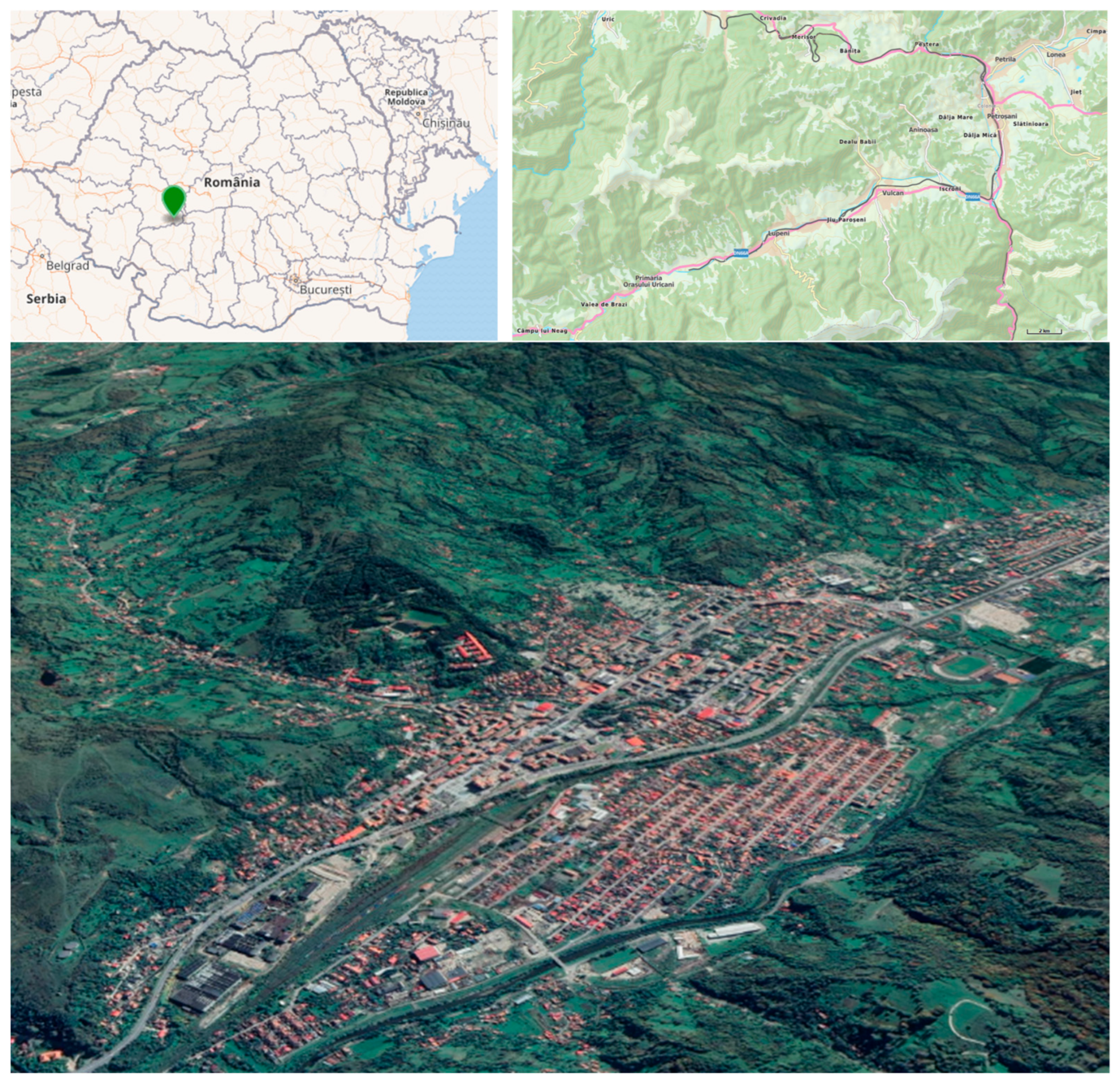
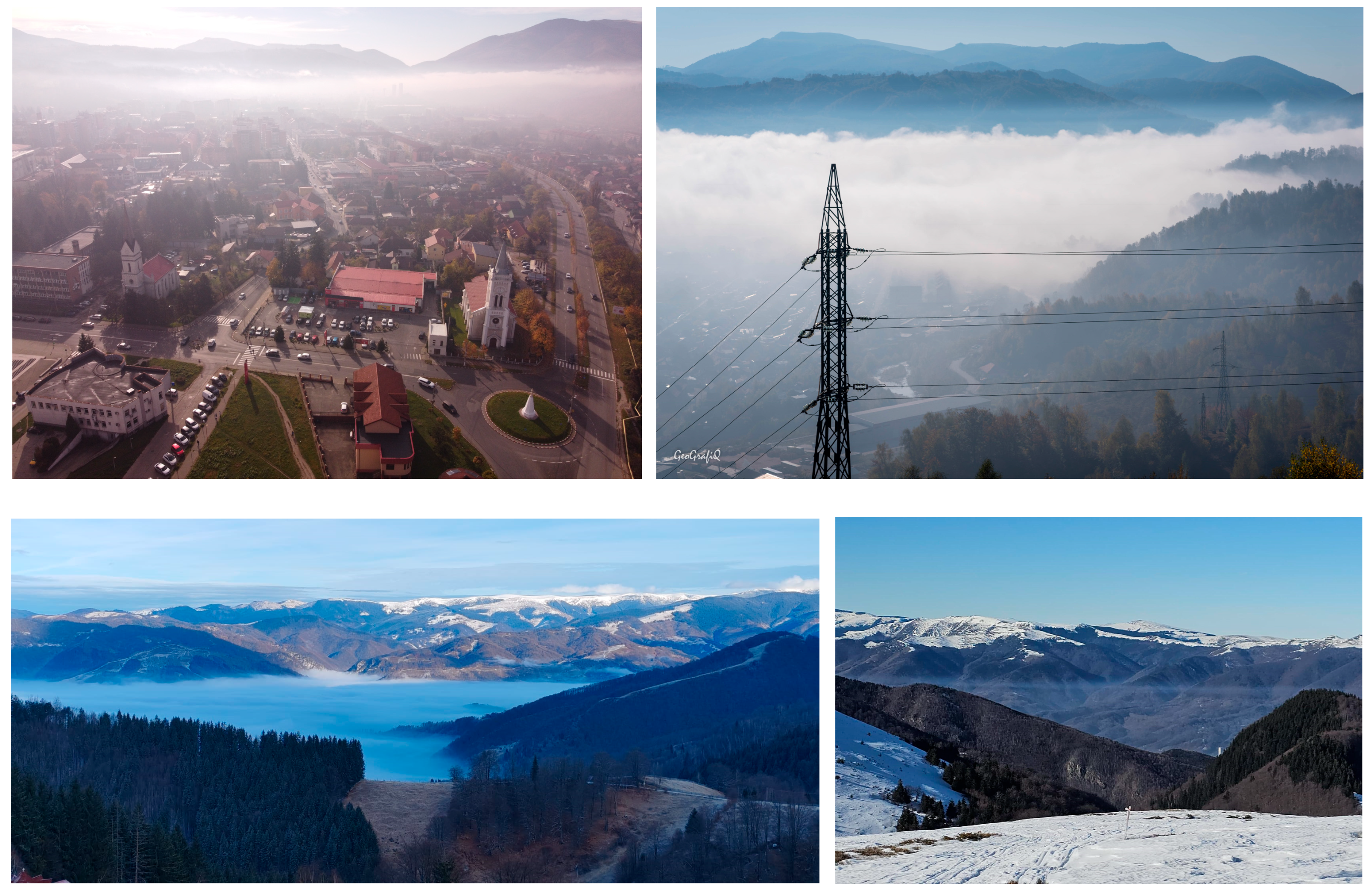
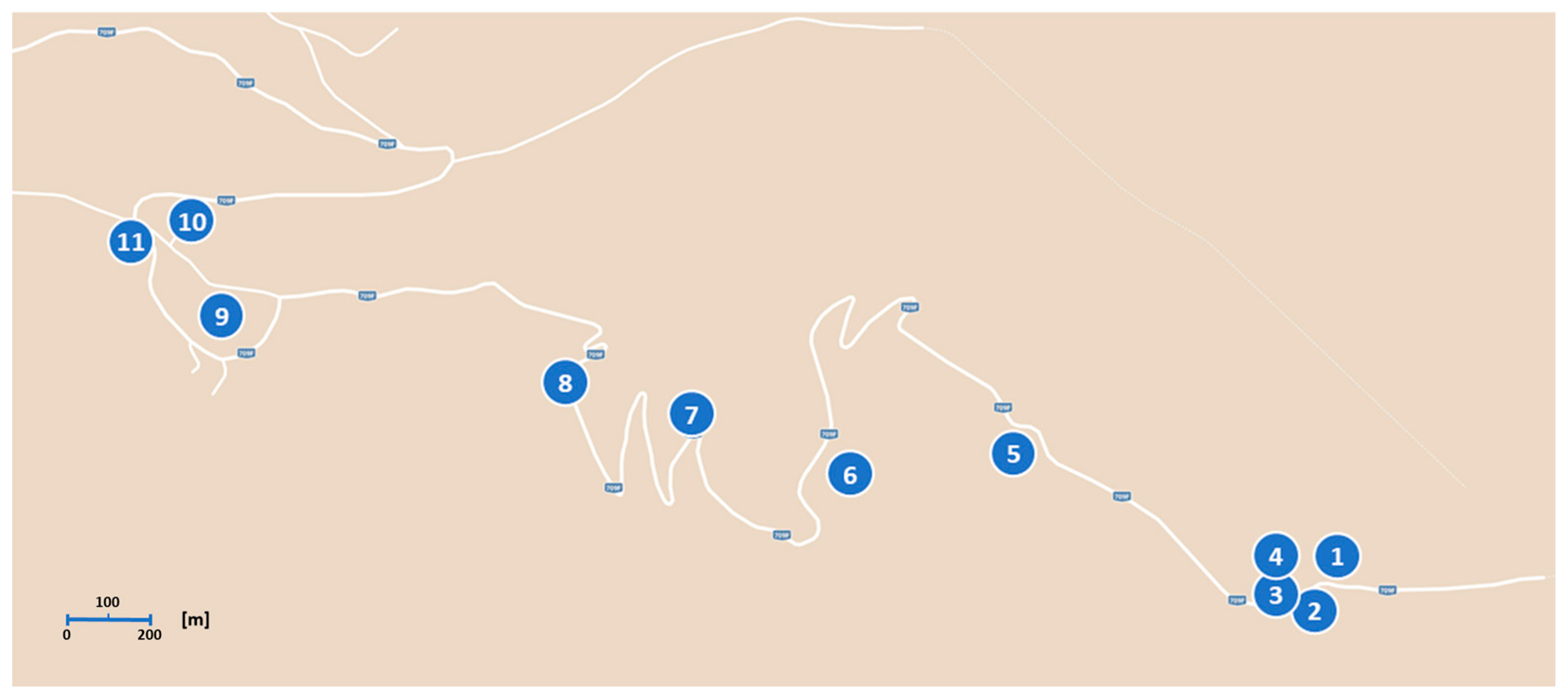
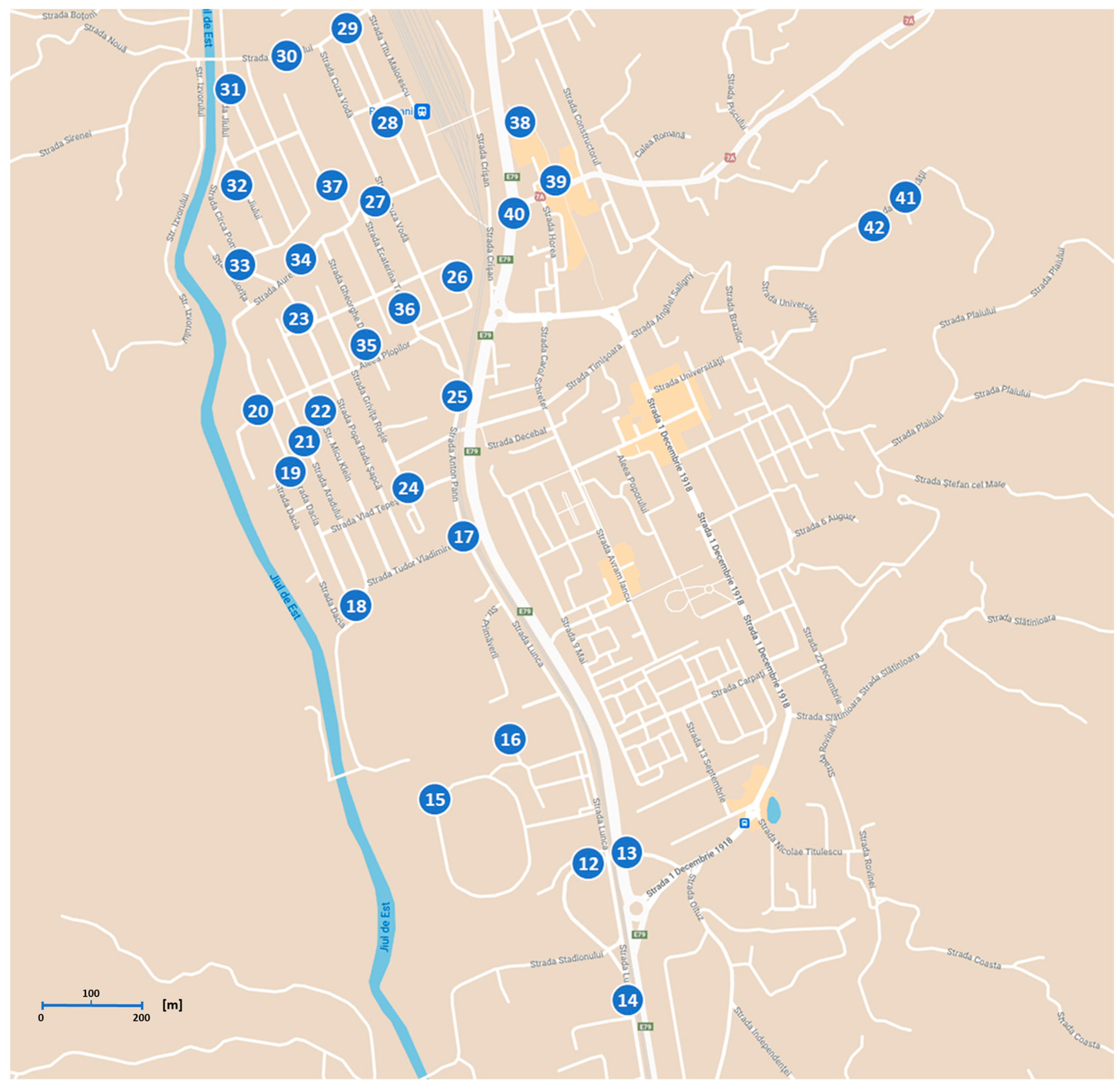
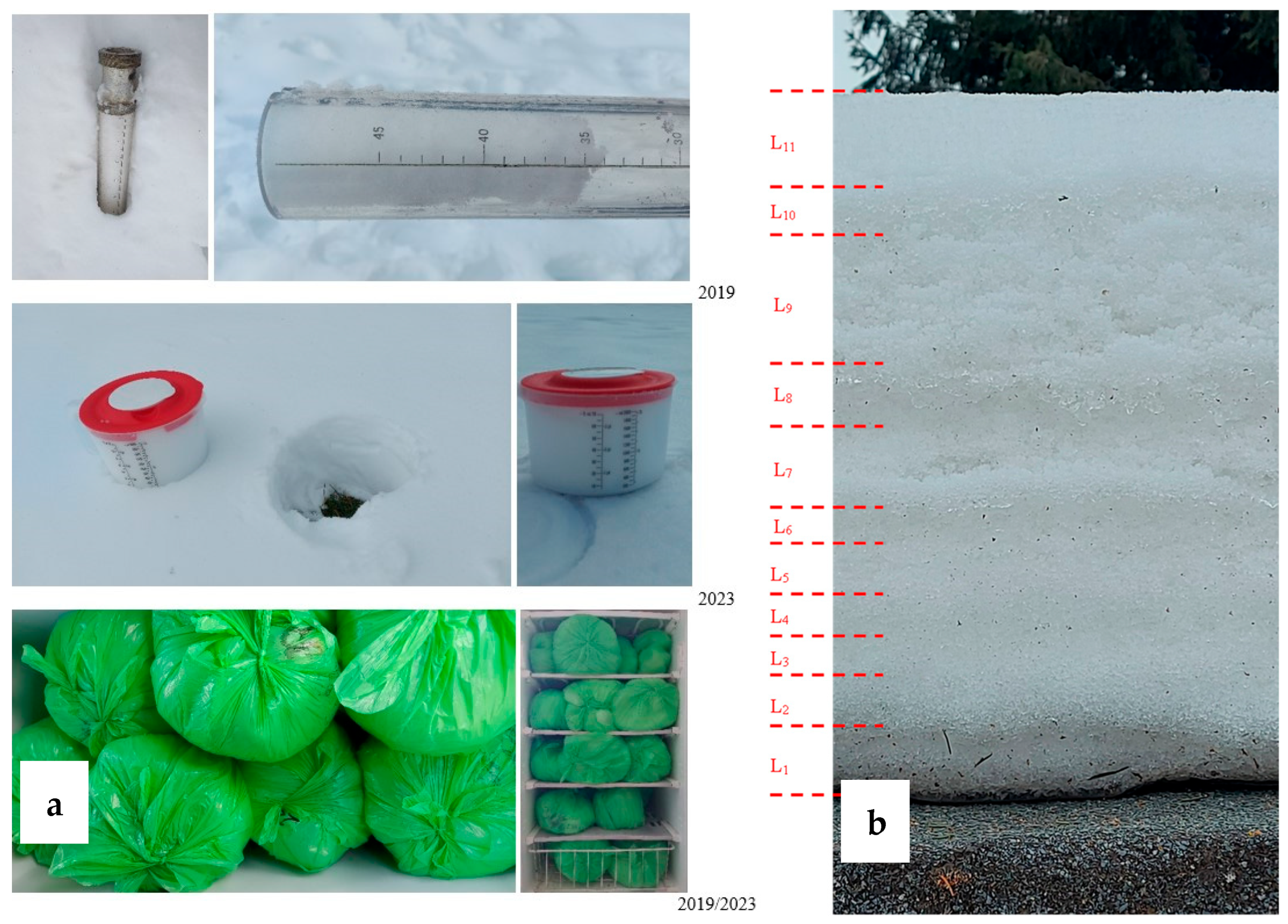
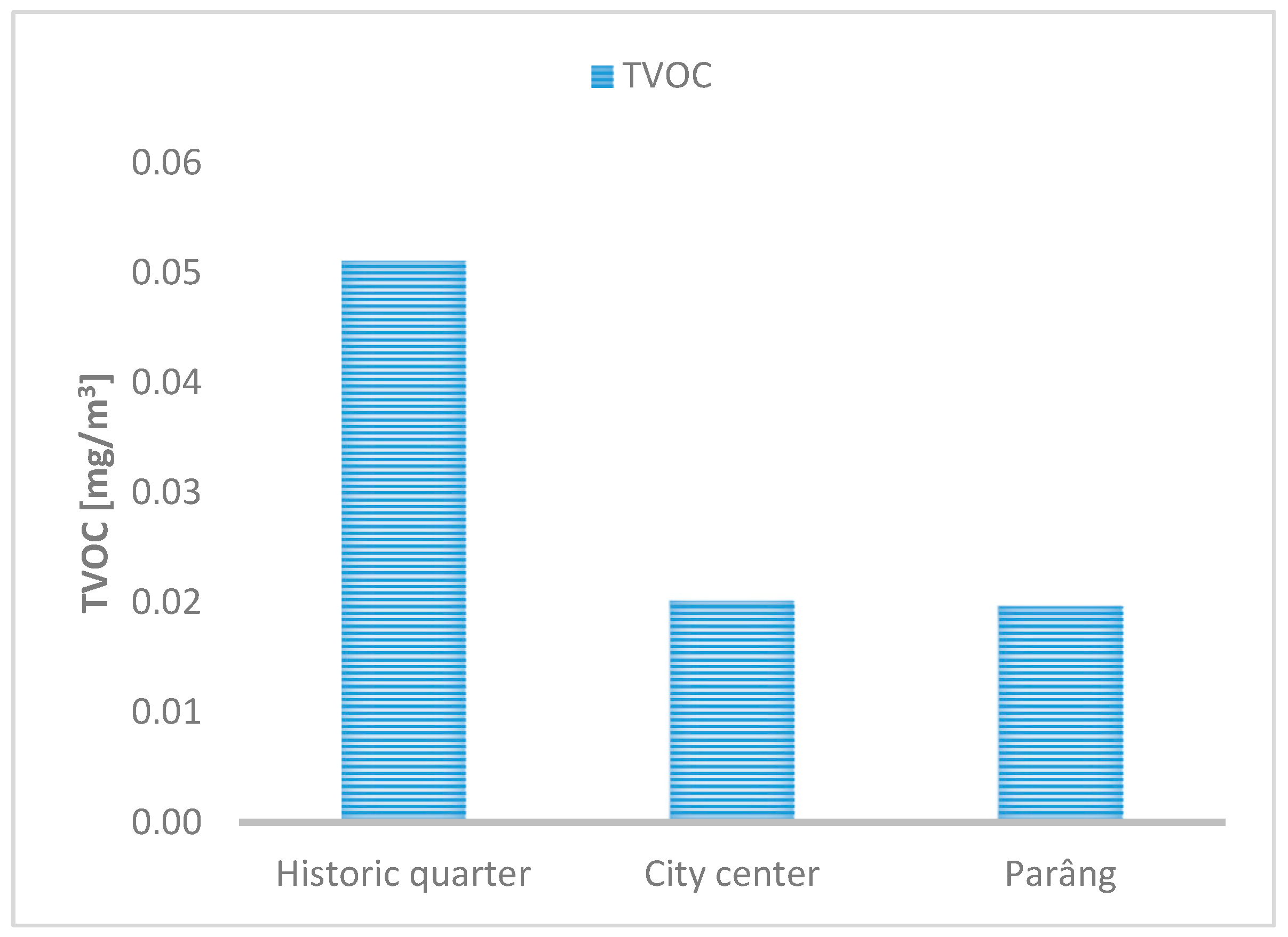
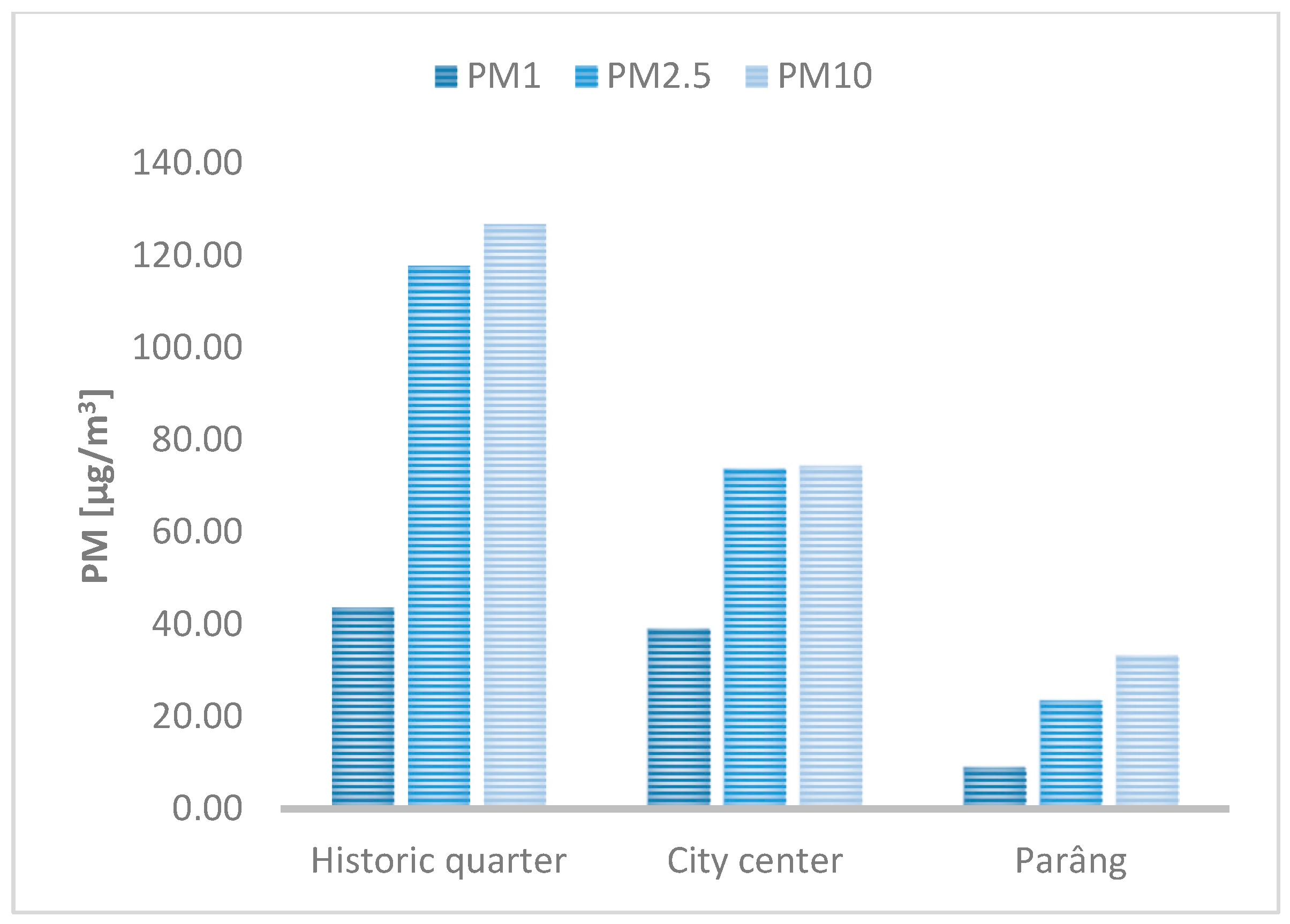

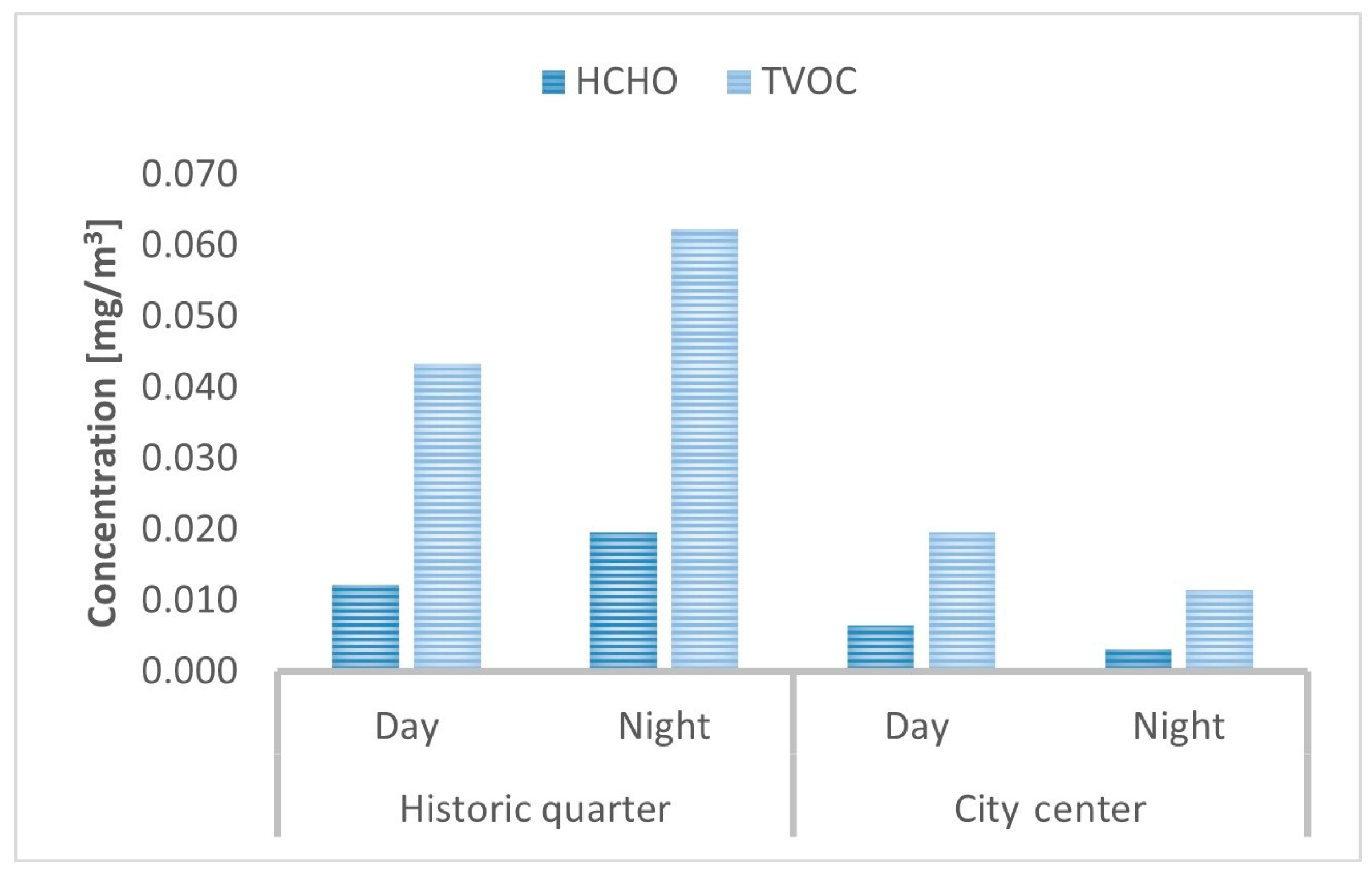
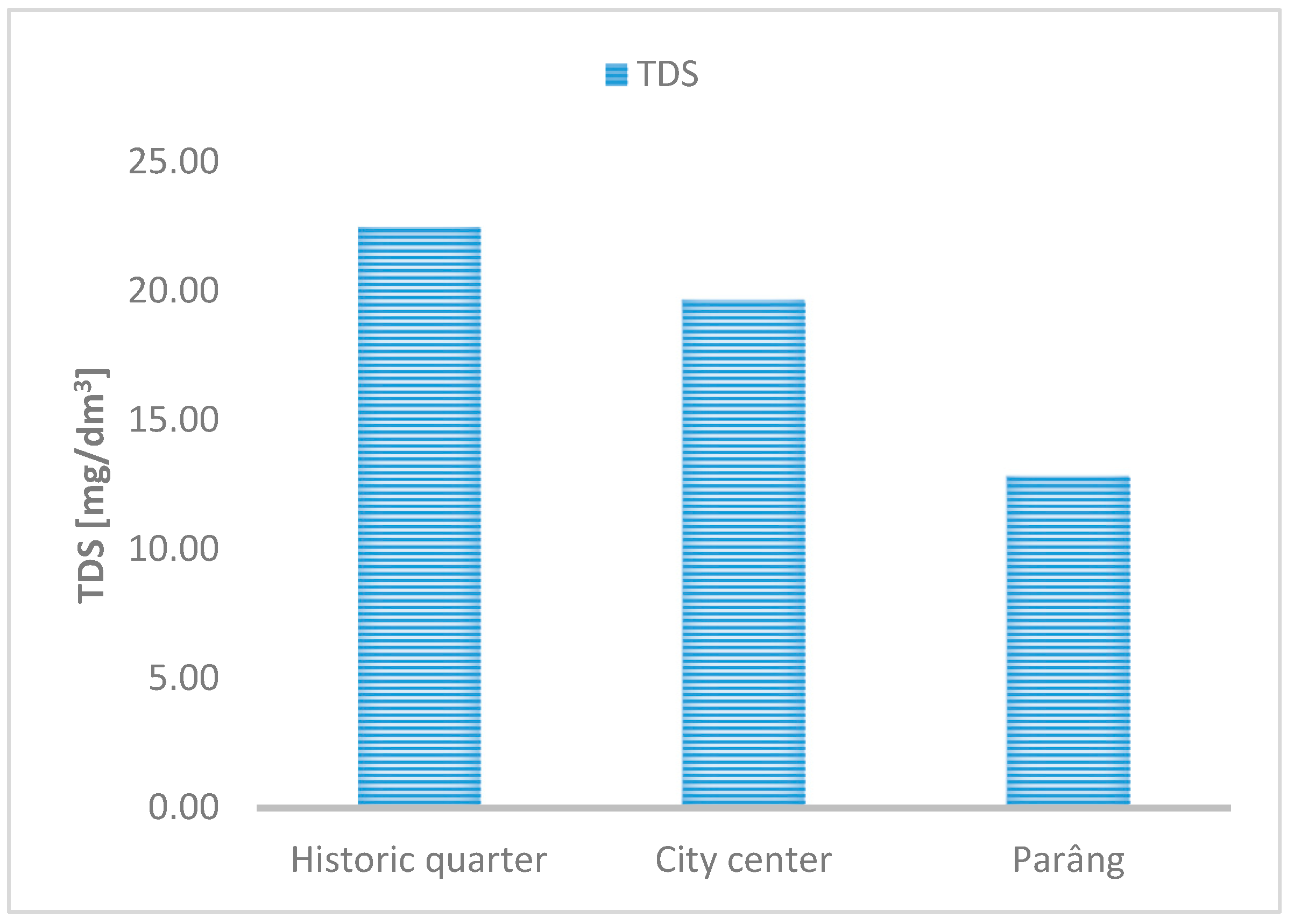
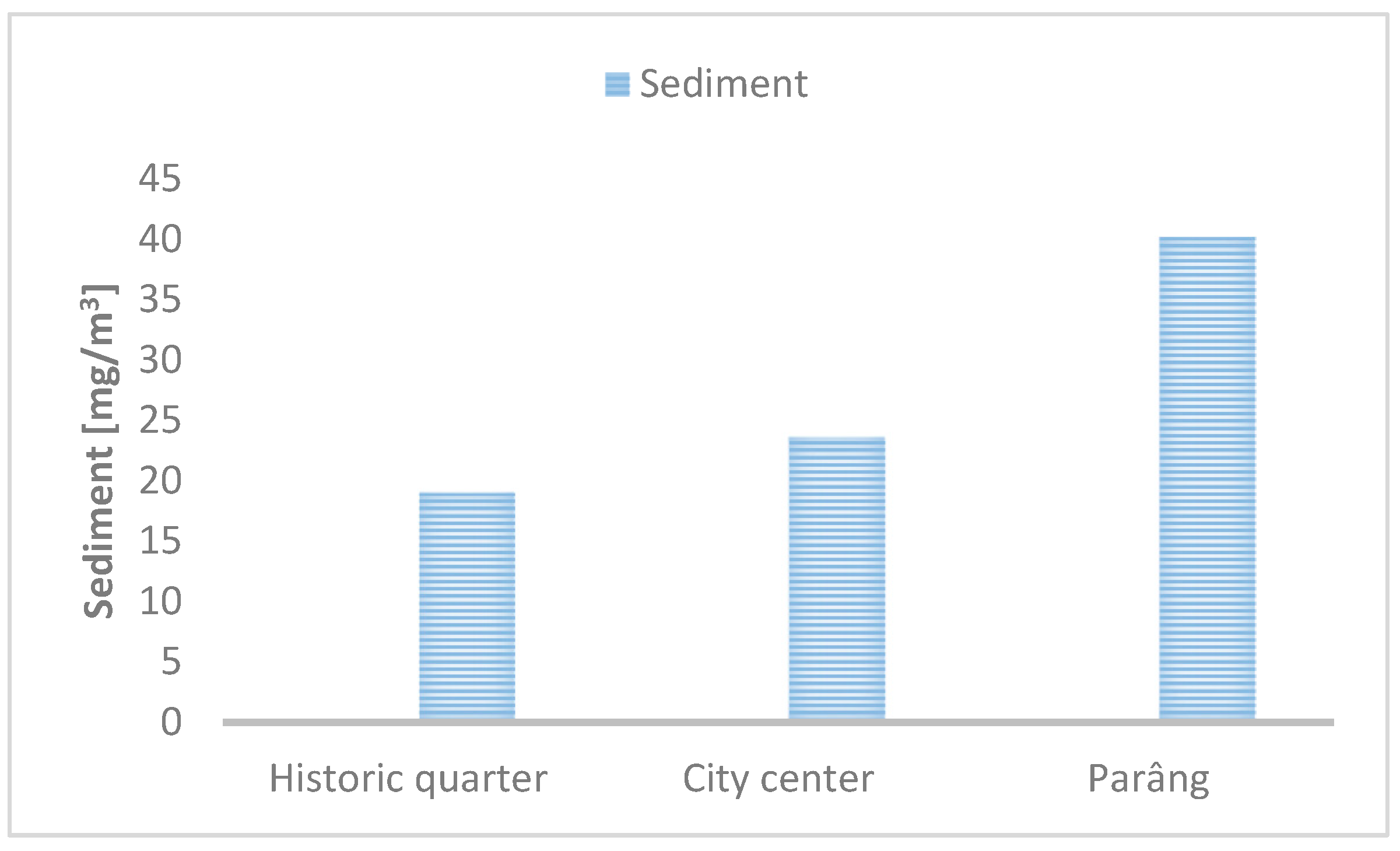
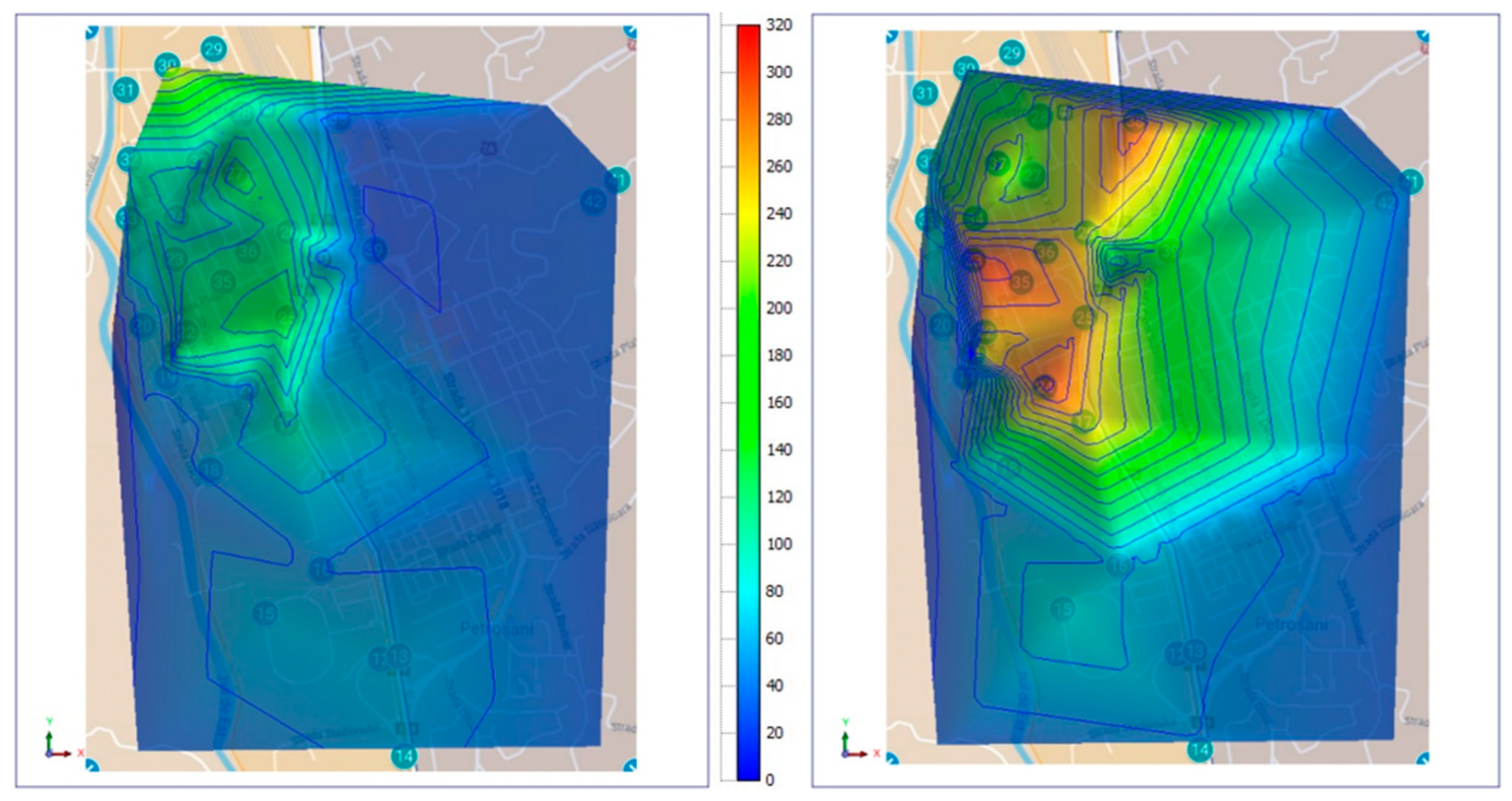


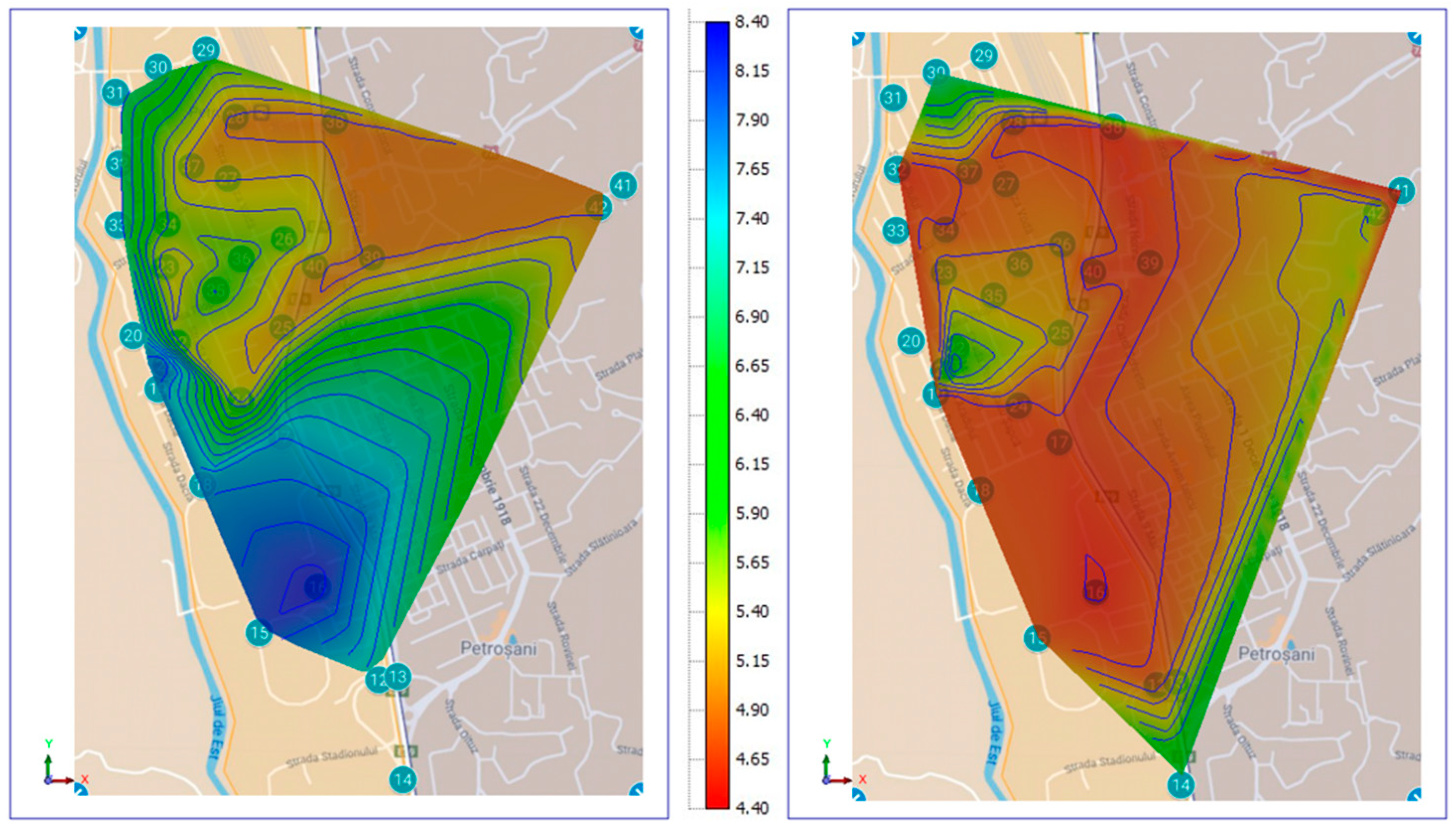
| Monitoring Point Number | Name/Location | Height of the Snow Sample 2019 * [mm] | Height of the Snow Sample 2023 ** [mm] | Instrumental |
|---|---|---|---|---|
| Winter 2023 | ||||
| 1 | Parâng Zone/Școala Sportivă/ANEFS | 500 | 120 | √ |
| 2 | Parâng Zone/La Răzvan Chalet | 500 | 120 | √ |
| 3 | Parâng Zone/Upper ramp old chairlift | 500 | 120 | √ |
| 4 | Parâng Zone/Upper ramp new chair lift | 500 | 120 | √ |
| 5 | Parâng Zone/Meteo Chalet | 500 | 120 | √ |
| 6 | Parâng Zone/Poiană | 500 | 120 | √ |
| 7 | Parâng Zone/Intermediate ramp new chair lift | 500 | 120 | √ |
| 8 | Parâng Zone/Road/Pillar | 500 | 120 | √ |
| 9 | Rusu/Cabana Rusu | 500 | 120 | √ |
| 10 | Rusu Zone/Codruț Chalet | 500 | 120 | √ |
| 11 | Rusu Zone/Plai Chalet | 500 | 120 | √ |
| 12 | Historic quarter/Str. Minei Street | 300 | 120 | √ |
| 13 | Historic quarter/Viaduct | √ | ||
| 14 | Historic quarter/DEDEMAN construction site | 120 | √ | |
| 15 | Historic quarter/Jiul Stadium | 360 | 120 | √ |
| 16 | Historic quarter/Vișinilor Street/Wooden Church | 700 | 120 | √ |
| 17 | Historic quarter/Intersection Anton Pann Street/Tudor Vladimirescu Street (Pensioners’ House) | 300 | 120 | √ |
| 18 | Historic quarter/Intersection √cia Street/Tudor Vladimirescu Street, No. 20 | 400 | ||
| 19 | Historic quarter/Dacia Street, Bl. M3 | 400 | 120 | √ |
| 20 | Historic quarter/Dacia Street, No. 7 | 300 | ||
| 21 | Historic quarter/Aradului Street, No. 22 | 50 | 120 | √ |
| 22 | Historic quarter/Micu Klein Street, No. 23/28 | 400 | ||
| 23 | Historic quarter/Radu Șapcă Street, No. 1 | 300 | 120 | √ |
| 24 | Historic quarter/Intersecțion Grivița Roșie Street /Vlad Țepeș Street (La Belle Epoque Restaurant) | 600 | 120 | √ |
| 25 | Historic quarter/Anton Pan Street, No. 56 | 300 | 120 | √ |
| 26 | Historic quarter/Egalității Street, No. 10 | 600 | 120 | √ |
| 27 | Historic quarter/Cuza Vodă Street, No. 28 | 500 | √ | |
| 28 | Historic quarter/Mihai Eminescu Street, No. 21 | 500 | 120 | √ |
| 29 | Historic quarter/Mihai Eminescu Street Continuation | 600 | ||
| 30 | Historic quarter/Cărbunelui Street | 540 | 120 | √ |
| 31 | Historic quarter/Extension of Kogălniceanu Street, Near Jiu | 540 | ||
| 32 | Historic quarter/Jiului Street | 540 | 120 | √ |
| 33 | Historic quarter/Intersection Sarmisegetusa Street/Circa pompieri Street/Miorița Street | 450 | ||
| 34 | Historic quarter/Aurel Vlaicu Street, No. 24 | 540 | 120 | √ |
| 35 | Historic quarter/Gheorghe Doja Street, No. 21/22 | 450 | ||
| 36 | Historic quarter/Ecaterina Teodoroiu Street, No. 22 | 540 | ||
| 37 | Historic quarter/Gheorghe Barițiu Street, No. 22 | 540 | 120 | √ |
| 38 | Central Zone/North Zone, Artesian fountain | 500 | 120 | √ |
| 39 | Central Zone/Dramatic Theatre I.D. Sîrbu | 500 | 120 | √ |
| 40 | Central Zone/St. Barbara Church | 500 | 120 | √ |
| 41 | Brădet Zone/Universității Street, Villas | 500 | 120 | √ |
| 42 | Brădet Zone/Universității Street, Știința Stadium | 500 | 120 | √ |
| Sampling Campaign | Sampling Date | Date of Installation of Persistent Snow Layer | Maximum Snow Layer Height [cm] | Snow Layer Height on the Sampling Date [cm] | Number of Days of Pollutant Accumulation |
|---|---|---|---|---|---|
| 2019 Campaign | |||||
| Petroșani | 2–3 February 2019 | 12 December 2018 | 59 | 12 | 53 |
| Parâng | 2–3 February 2019 | 6 December 2018 | 102 | 96 | 59 |
| 2023 Campaign | |||||
| Petroșani | 12–14 February 2023 | 27 January 2023 | 41 | 14 | 18 |
| Parâng | 12–14 February 2023 | 10 January 2023 | 78 | 60 | 35 |
| Sampling Campaign | Tmin Med [°C] | Tmax Med [°C] | Tmin Period [°C] | Tmax Period [°C] | Number of Days of Snow Accumulation | Number of Days with Tmin > 0 | Number of Days with Tmax > 0 |
|---|---|---|---|---|---|---|---|
| 2019 Campaign | |||||||
| Petroșani | −4.5 | 1.5 | −19.9 | 9.4 | 53 | 7 | 36 |
| Parâng | −7.5 | −2.7 | −16.7 | 3.9 | 59 | 1 | 13 |
| 2023 Campaign | |||||||
| Petroșani | −8.0 | 1.5 | −18.6 | 6.5 | 18 | 0 | 14 |
| Parâng | −6.8 | −1.7 | −15.1 | 5.2 | 35 | 1 | 14 |
| Sampling Campaign | Days with Precipitation | Days with Precipitation > 5 mm | Days with Precipitation > 10 mm | Average Precipitation [mm] | Percentage of Days with Precipitation [%] |
|---|---|---|---|---|---|
| 2019 Campaign | |||||
| Petroșani | 40 | 12 | 8 | 5.2 | 75.5 |
| Parâng | 48 | 20 | 8 | 5.1 | 81.4 |
| 2023 Campaign | |||||
| Petroșani | 7 | 6 | 3 | 4.9 | 38.9 |
| Parâng | 24 | 14 | 12 | 11.0 | 68.6 |
| 2019 Campaign | 2023 Campaign | |||||||
|---|---|---|---|---|---|---|---|---|
| Petroșani | Parâng | Petroșani | Parâng | |||||
| Average wind speed [m/s] | 1.0 | 1.5 | 1.1 | 1.9 | ||||
| Maximum wind speed [m/s] | 4 | 5 | 5 | 9 | ||||
| Number of hours with wind speeds corresponding to the Beaufort scale: | ||||||||
| <0.2 m/s (Bf = 0) | 318 | 132 | 109 | 93 | ||||
| 0.2–1.4 m/s (Bf = 1) | 703 | 599 | 227 | 282 | ||||
| 1.4–3.0 m/s (Bf = 2) | 242 | 654 | 114 | 371 | ||||
| 3.0–5.3 m/s (Bf = 3) | 7 | 27 | 6 | 80 | ||||
| 5.3–7.8 m/s (Bf = 4) | 0 | 0 | 0 | 12 | ||||
| 7.8–10.6 m/s (Bf = 5) | 0 | 0 | 0 | 1 | ||||
| 10.6–13.6 m/s (Bf = 6) | 0 | 0 | 0 | 0 | ||||
| Dominant wind directions and their respective percentages [%] | ||||||||
| Direction | Percentage | Direction | Percentage | Direction | Percentage | Direction | Percentage | |
| Main direction | S | 14.6 | N | 30.9 | S | 14.3 | NNE | 25.0 |
| Secondary direction I | SE | 10.7 | S | 14.7 | N | 9.6 | N | 20.8 |
| Secondary direction II | SSE | 10.7 | SSV | 11.2 | VNV | 7.9 | S | 15.0 |
| Secondary direction III | SSV | 6.6 | NNE | 9.1 | SSE | 7.2 | SSE | 7.3 |
| Average gust value [m/s] | NA | 4.8 | NA | 5.7 | ||||
| Maximum gust value [m/s] | NA | 13 | NA | 23 | ||||
| Number of gusts where the wind speed corresponds to the Beaufort scale | ||||||||
| 5.3–7.8 m/s (Bf = 4) | NA | 500 | NA | 461 | ||||
| 7.8–10.6 m/s (Bf = 5) | NA | 291 | NA | 124 | ||||
| 10.6–13.6 m/s (Bf = 6) | NA | 77 | NA | 34 | ||||
| 13.6–17.0 m/s (Bf = 7) | NA | 0 | NA | 8 | ||||
| 17.0–20.6 m/s (Bf = 8) | NA | 0 | NA | 0 | ||||
| 20.6–24.0 m/s (Bf = 9) | NA | 0 | NA | 0 | ||||
| Parameter | UM | Historic Quarter | City Center | Parâng Area |
|---|---|---|---|---|
| PM1 | [µg/m3] | 43.78 | 39.08 | 9.00 |
| PM2.5 | [µg/m3] | 117.89 | 73.75 | 23.58 |
| PM10 | [µg/m3] | 126.89 | 74.33 | 33.17 |
| CO2 | [ppm] | 600.22 | 475.42 | 497.08 |
| HCHO | [mg/m3] | 0.02 | 0.01 | 0.01 |
| TVOC | [mg/m3] | 0.05 | 0.02 | 0.02 |
| Parameter | UM | Historic Quarter | City Center | Parâng |
|---|---|---|---|---|
| TDS | mg/dm3 | 22.49 | 19.66 | 12.84 |
| Conductivity | µS/cm | 45.07 | 40.00 | 26.36 |
| Ca2+ | mg/dm3 | 4.21 | 3.34 | 2.65 |
| Mg2+ | mg/dm3 | 1.52 | 1.40 | 1.18 |
| SO42− | mg/dm3 | 9.87 | 8.48 | 7.38 |
| Sediment | mg/m2 | 19.00 | 23.60 | 40.22 |
| Criterion | Instrumental Monitoring | Pollutant Determination in Snow |
|---|---|---|
| Measurement Frequency | Continuous, real-time (24/7) | Periodic, based on collected snow samples |
| Measured Parameters | Gaseous pollutants, particles (PM), humidity, temperature | Dissolved substances, solid particles, sediments, and conductivity |
| Sensitivity | Highly sensitive, detects pollution fluctuations rapidly | Provides average values over longer periods |
| Applications | Rapid assessment, real-time pollution alerts | Long-term pollution accumulation studies and air quality analysis in the cold season |
| Costs | High (equipment, maintenance, calibration) | Relatively low (sampling and laboratory analysis) |
| Equipment Complexity | Requires sensors and advanced data processing systems | Requires laboratory equipment for chemical analysis |
| Meteorological Impact | Influenced by factors such as wind, temperature, humidity | Influenced by snow persistence duration and deposition conditions |
| Coverage Area | Localized measurements specific to sensor placement | Integrates pollutants from a wider area through snow accumulation |
Disclaimer/Publisher’s Note: The statements, opinions and data contained in all publications are solely those of the individual author(s) and contributor(s) and not of MDPI and/or the editor(s). MDPI and/or the editor(s) disclaim responsibility for any injury to people or property resulting from any ideas, methods, instructions or products referred to in the content. |
© 2025 by the authors. Licensee MDPI, Basel, Switzerland. This article is an open access article distributed under the terms and conditions of the Creative Commons Attribution (CC BY) license (https://creativecommons.org/licenses/by/4.0/).
Share and Cite
Lorinț, C.; Traistă, E.; Florea, A.; Marchiș, D.; Radu, S.M.; Nicola, A.; Rezmerița, E. Spatiotemporal Distribution and Evolution of Air Pollutants Based on Comparative Analysis of Long-Term Monitoring Data and Snow Samples in Petroșani Mountain Depression, Romania. Sustainability 2025, 17, 3141. https://doi.org/10.3390/su17073141
Lorinț C, Traistă E, Florea A, Marchiș D, Radu SM, Nicola A, Rezmerița E. Spatiotemporal Distribution and Evolution of Air Pollutants Based on Comparative Analysis of Long-Term Monitoring Data and Snow Samples in Petroșani Mountain Depression, Romania. Sustainability. 2025; 17(7):3141. https://doi.org/10.3390/su17073141
Chicago/Turabian StyleLorinț, Csaba, Eugen Traistă, Adrian Florea, Diana Marchiș, Sorin Mihai Radu, Aurelian Nicola, and Evelina Rezmerița. 2025. "Spatiotemporal Distribution and Evolution of Air Pollutants Based on Comparative Analysis of Long-Term Monitoring Data and Snow Samples in Petroșani Mountain Depression, Romania" Sustainability 17, no. 7: 3141. https://doi.org/10.3390/su17073141
APA StyleLorinț, C., Traistă, E., Florea, A., Marchiș, D., Radu, S. M., Nicola, A., & Rezmerița, E. (2025). Spatiotemporal Distribution and Evolution of Air Pollutants Based on Comparative Analysis of Long-Term Monitoring Data and Snow Samples in Petroșani Mountain Depression, Romania. Sustainability, 17(7), 3141. https://doi.org/10.3390/su17073141






